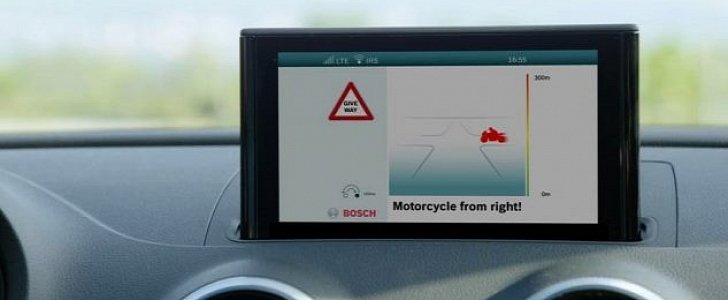Let’s be honest, loud pipes won’t save you if the driver in a modern, very well insulated car has his sound system blasting some Drake and is two-finger digging into his smartphone. But don’t worry because Bosch is developing a way to alert people that you are coming.
Tech giant Bosch announced it has developed a prototype vehicle-to-vehicle communication system that will reduce the risk of accidents. The company describes it as a “digital protection shield” that should, in theory, keep you in a safe virtual bubble while riding.
The biggest problem with motorcycles is that they are hard to spot by other drivers, but Bosch’s system will enable vehicles to share their location, direction, and speed as well as warn drivers/riders of possible collisions that might happen.
Here is how it works: up to ten times a second, vehicles within a radius of several hundred meters exchange information about vehicle types, speed, position, and direction of travel. Long before drivers or their vehicles’ sensors catch sight of a motorcycle, this technology informs them that a motorcycle is approaching, allowing them to adopt a more defensive driving strategy.
For example, typical dangerous situations arise when a motorcycle approaches a car from behind on a multi-lane road, ends up in a car’s blind spot, or changes lanes to pass. If the system identifies a potentially dangerous situation, it can warn the rider or driver by sounding an alarm and flashing a warning notice on the dashboard. In this way, all road users receive essential information that actively helps avoid accidents.
Another interesting thing to mention is that the public WLAN standard (ITS G5) will be used as the basis for the data exchange between motorcycles and cars which takes only milliseconds to be sent and received.
Parked or idling vehicles also transmit data to any surrounding receivers. To allow riders and drivers who are farther away to reliably receive data, the technology will use a multi-hopping method, which forwards the information from vehicle to vehicle as if it were a large scale network.
The biggest problem with motorcycles is that they are hard to spot by other drivers, but Bosch’s system will enable vehicles to share their location, direction, and speed as well as warn drivers/riders of possible collisions that might happen.
Here is how it works: up to ten times a second, vehicles within a radius of several hundred meters exchange information about vehicle types, speed, position, and direction of travel. Long before drivers or their vehicles’ sensors catch sight of a motorcycle, this technology informs them that a motorcycle is approaching, allowing them to adopt a more defensive driving strategy.
For example, typical dangerous situations arise when a motorcycle approaches a car from behind on a multi-lane road, ends up in a car’s blind spot, or changes lanes to pass. If the system identifies a potentially dangerous situation, it can warn the rider or driver by sounding an alarm and flashing a warning notice on the dashboard. In this way, all road users receive essential information that actively helps avoid accidents.
Another interesting thing to mention is that the public WLAN standard (ITS G5) will be used as the basis for the data exchange between motorcycles and cars which takes only milliseconds to be sent and received.
Parked or idling vehicles also transmit data to any surrounding receivers. To allow riders and drivers who are farther away to reliably receive data, the technology will use a multi-hopping method, which forwards the information from vehicle to vehicle as if it were a large scale network.




